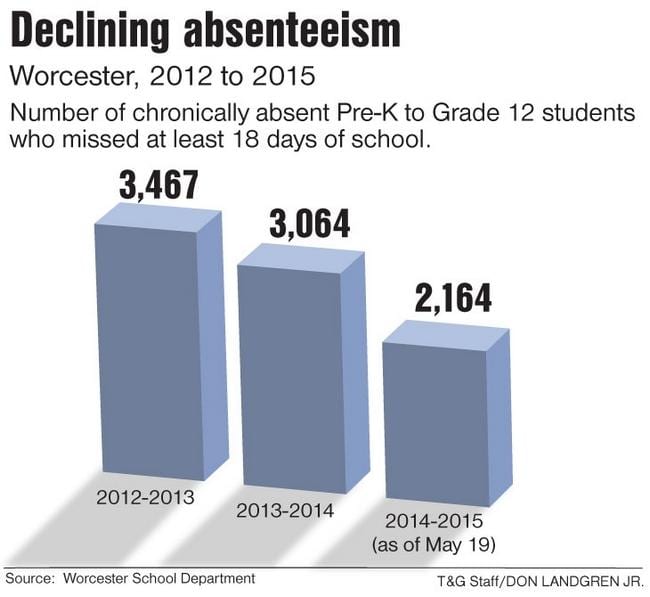
June 3, 2015
Worcester schools’ chronic absentee rates decline: legal aid plays a part.
-
Worcester schools’ chronic absentee rates decline
Posted Jun. 2, 2015 at 6:59 PM
[[{“type”:”media”,”view_mode”:”media_large”,”fid”:”332″,”attributes”:{“alt”:””,”class”:”media-image”,”height”:”441″,”typeof”:”foaf:Image”,”width”:”480″}}]]
WORCESTER – During the past three years, chronic absenteeism in the city’s public schools has dropped off steadily, but some elected officials are calling for continued intervention to keep the rates from going up again.
As of a count provided to the School Committee’s Teaching, Learning and Student Supports Standing Committee on May 19, there had been 2,164 students in prekindergarten through 12th grade who had missed at least 18 days of school this year. While there was still a month of school left to go, that total was 900 fewer than last year’s tally, and 1,303 fewer than in 2012-13, according to the district’s records.
The middle school grades in particular saw significant declines in the number of chronically absent students. In the seventh and eighth grades, for instance, the yearly total of 213 as of May 19 was less than half the final number a year ago.
Marco Rodrigues, the district’s chief academic officer, said school officials three years ago began to focus more closely on the district’s issues with chronic absenteeism, which the state defines as a student missing at least 10 percent of school days a year. Mr. Rodrigues clarified that absenteeism is different from truancy, and that some of the district’s efforts to solve the former have centered on learning more about chronic health problems that keep kids out of school.
A new pilot intervention program between the schools and UMass Memorial Health Care at Belmont Street Community School, for instance, has helped reduce the number of students missing school because of their asthma, Mr. Rodrigues said. Launched in the spring of 2013, the initiative sent a couple of community health workers from UMass Memorial to the homes of families with asthmatic children to help them better manage the factors that might have been exacerbating their kids’ condition.
“For some families, it was not understanding the medication,” said Monica Lowell, UMass Memorial’s vice president of community relations. “For others, they were living in homes where they had problems with mold or rodent infestation, but were afraid to speak up, because they thought they might be evicted.”
After partnering with some other local organizations, like Community Legal Aid, to help those families, the program saw a steep decline in the number of need-based referrals: after starting with around 20 participating households from the Belmont Street School the first year, for instance, only two were referred this past year, according to Ms. Lowell. Thanks to special state funding program coordinators secured last year, there is now a citywide initiative aimed at tackling Worcester’s pediatric asthma problem, she added, which is helping to train nurses throughout the school system.
The schools have also zeroed in on several other problem areas, like diabetes, as well as partnered with the state Department of Children and Families and the court system to help families get intervention for children missing school, Mr. Rodrigues said.
“It’s understanding (families’) challenges that I think has made a difference” in reducing absenteeism, he said. “We have received good results.”
School Committee member John Monfredo, the vice chairman of the Teaching, Learning and Student Supports Standing Committee, wants the district to make other efforts to tackle absenteeism next school year. Among the steps he proposed at the standing committee’s May meeting were running another public campaign about the importance of kids attending school; offering incentives for attendance; and obtaining and analyzing more data about why children are missing school.
“It’s something we really need to stay on top of,” Mr. Monfredo said. “Because if we don’t, we’ll start reverting backwards.”
Despite the downward trend the past few years, Worcester’s chronic absenteeism rate of 14.4 percent last school year was still higher than the state average of 12.3 percent, according to Massachusetts Department of Elementary and Secondary Education statistics.
Scott O’Connell can be reached at Scott.O’Connell@telegram.com. Follow him on Twitter @ScottOConnellTG

















































